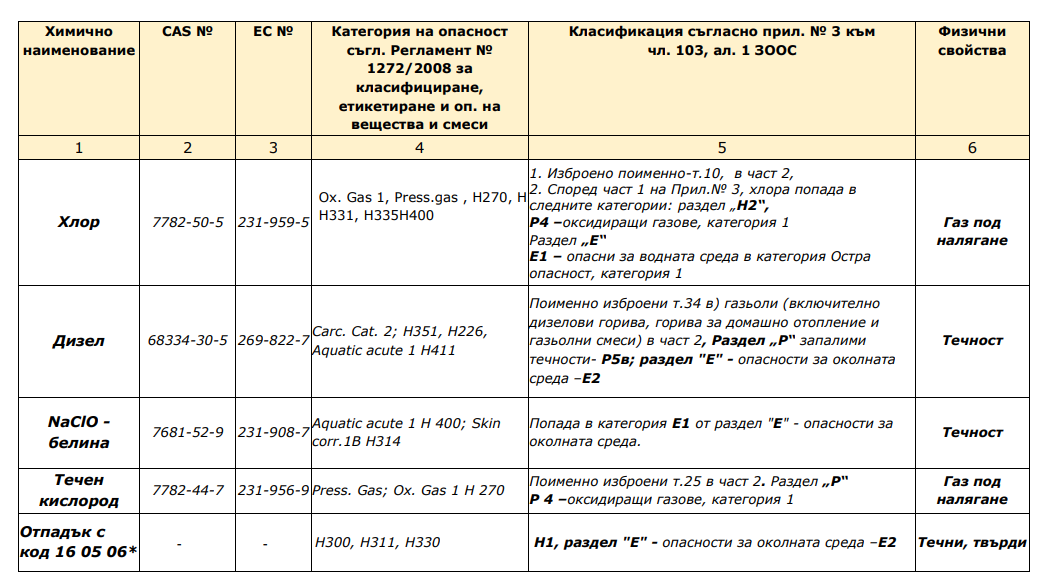Information on the planned safety measures and the modes of action in case of an accident
In Bulgaria, water for domestic use is disinfected with chlorine gas, sodium hypochlorite, ozone or chlorine dioxide in accordance with Ordinance 2/ 22 March 2005. Chlorine is among the most widely used disinfectants worldwide in the treatment of water intended for domestic use. Some of the main reasons are the highly reliable bactericidal action, easy application and cost effectiveness.
In the potable water treatment plants Bistritsa and Pancharevo, raw water undergoes processes of physical and chemical treatment, as disinfection is the last stage before water is delivered to the customers. The following processes are carried out in a sequence:
- chlorination for oxidation of organic matter and bacterial mass in water;
- contact coagulation for consolidation of the suspended solids;
- filtration;
- chlorine disinfection.
Pre-oxidation and primary decontamination of the treated water with chlorine is carried out through the constructed for the purpose chlorination station with the adjacent to it chlorination warehouse. The technology used is recognized as one of the most modern ones in the sector.
There is a chlorine gas warehouse in Bistritsa PWTP. The closest constructions, residential buildings, etc. that could be affected by an accident are in the perimeter of a circle with radius 1000 m around the chlorination station.
Storage and use of hazardous chemical substances and mixtures
The chemical substances and mixtures, located on the company’s site, are limited to chlorine, diesel fuel, bleach and oxygen.

Measures in advance for adequate population behavior in case of a chlorine-related accident
What do we need to know about chlorine (Cl)?
Chlorine is a greenish yellow gas with a pungent odor, heavier than air. It is used for water disinfection in the city of Sofia.
The levels of residual chlorine in potable water are continuously monitored and controlled.
What makes it hazardous?
H 270 – Oxidizing gases;
H 315 – Corrosive / causes skin irritation;
H 319 – Causes serious eye irritation;
H 331 – Toxic if inhaled;
H 335 – May cause respiratory irritation;
H 400 – Harmful to the environment. Very toxic to aquatic life.
What is its effect on human health and the environment?
If inhaled by humans:
- at low concentrations - irritating.
- in high concentrations - acute inflammation, suffocation and death.
Destroys living organisms.
Does not burn, but supports combustion.
What action should be taken on receipt of an emergency chlorine release signal?
Upon receipt of the alert from the Civil Protection Service:
- Stay calm!
- Inform people around you about the danger.
If you are at home:
- Close doors, windows and vents tightly;
- Secure wet blankets, curtains, etc. to them;
- If possible, occupy upper floors;
- If you have a gas mask, put it on;
- If you don't have one, wet a gauze pad, cloth or towel with a 5% sodium bicarbonate (baking soda) solution.
If you are outdoors:
- Leave the gassed area by moving perpendicularly to wind direction;
- When leaving the gassed area remove and air your clothes;
- Rinse/flush your mouth, eyes and nose with 2% sodium bicarbonate solution;
- Wash your body with water and soap and put on clean clothes.
If you are in a vehicle:
- Close the windows;
- Leave the gassed area as quickly as possible.
How to administer first aid?
If inhaled:
• Remove person to fresh air;
• If possible provide the inhalation of 100% humidified oxygen;
Do not apply artificial respiration!
In case of contact with the skin:
• Remove contaminated clothing immediately;
• Cleanse thoroughly your skin with water or a 2% sodium bicarbonate solution for 15 minutes;
• In the presence of frostbite, use warm water to treat the affected area until it is fully warmed;
• Drink warm milk with sodium bicarbonate and coffee.
In case of contact with the eyes:
• Wash the eyes cautiously and abundantly with clean water, and if necessary keep the eyes open;
• Do not allow the victim to rub their eyes or keep them tightly closed until transported to a medical facility.
Is qualified medical assistance necessary? – IT IS MANDATORY!
Measures in advance for adequate behavior in case of a chlorine-related accident
• Dispersal of large amounts of water in the form of fine mist droplets.
• Do not use carbon dioxide!
Analysis of the emergency situations and the consequences thereof
The analysis of the consequences of the possible emergency situations for the personnel, the population and the environment on the territory of Bistritsa PWTP, the city of Sofia, is prepared on the basis of the requirements of art. 35, par. 1, it. 1 of the Disaster Protection Act. The main objective is to determine the most severe damage from identified accidents and to plan and take adequate measures to reduce the risk of major accidents and mitigate the consequences thereof. Within the scope of the assessment of possible emergency situations are the activities carried out with hazardous chemical substances and mixtures on the territory of Bistritsa PWTP, while the analysis of potential impacts also covers areas outside the establishment, to the extent applicable. The greatest hazards have been identified in the activities related to receiving and handling chlorine at the company’s chlorination unit.
The possible accidents resulting from the analysis are:
- Fire and explosion from natural gas leak;
- Chlorine leakage when unloading from vehicles;
- Leakage of a large amount of chlorine from the technological system;
The risk analyses and modelling taking account of the most significant potential damage include a scenario with a sudden leakage of a large amount of chlorine from the technological water disinfection system.
Safety measures planned by the company

Zone 1 – high mortality zone
This zone is located in the immediate proximity to the leakage point, where the exposure to high concentration of the toxic vapours of chlorine (20ppm) may have a lethal outcome due to respiratory arrest, corrosive organ changes, danger of tracheal perforation, pulmonary edema, etc. High mortality is anticipated in this zone.
Regarding this zone, the main control measures are the use of the appropriate class of equipment for all chlorine-related activities, maintenance of the technical and emergency systems in good order (non-destructive control of vessels and pipelines, hydraulic tests, gas detection, ventilation, maintenance of the scrubber system and the deactivation pits, etc.), adequate technical maintenance of the equipment by a competent personnel, strict compliance with the instructions on safe unloading, storage, transportation and handling, inspections, trainings on the hazards and the control measures, and application of good practices.
If it is not possible to stop the leakage of hazardous chemical substances and mixtures, employees have to be evacuated. Then it is necessary to take measures for separating the area and denying access to external persons. Medical assistance and emergency rescue assistance should be concentrated in this zone.
Zone 2 – severe damage zone
This is the zone immediately after Zone 1, where there may also be fatalities, but here, mainly serious adverse effects will be seen. The remoteness from the source of release determines the presence of less adverse health effects.
The specific smell of chlorine makes it easy to detect, and the normal behaviour of a person is to want to get out of the area if they smell it. In such situations, it is possible for panic to set in, making evacuation difficult especially among vulnerable persons (sick, mobility impaired, etc.), creating a prerequisite for physical accidents in case of collision with vehicles trying to leave the area.
The main measures are timely alerting through a warning system and readiness for evacuation from the affected area.
Compared to the first zone, here the provision of first aid is a lower priority.
Zone 3 – zone of special attention
This is the zone furthest from the site where the accident has occurred and where adverse effects are also expected, but weaker. Specific measures should be planned for it in terms of vulnerable areas (kindergartens, hospitals, nursing homes, etc.), if any, and zone entry control should be in place.
The main measures are related to the vulnerable areas, preventing zone entry, as well as measures for ensuring information and timely communication.
First, in order to prevent the occurrence of emergency situations, and then, to limit the spread of the accident and eliminate the consequences both within and outside the area, the company has taken and maintains the following measures:
- only tested equipment in good technical order is used and maintained for all chlorine-related activities;
- maintenance of emergency systems (scrubber system, degassing pits, gas detection, ventilation, etc.);
- adequate maintenance of the equipment of the chlorination plant by competent staff;
- technical inspections and control of safety critical elements of the facilities (detection of defects of containers and pipes, water samples, inspection and calibration of sensors, shut-off valves, etc.);
- controlled access to the site and hazardous chemical substances and mixtures storage areas;
- organization of work to avoid sources of ignition and associated risks (for example, hot works permit, etc.);
- maintenance of emergency response team and emergency equipment;
- physical control during unloading of hazardous chemical substances and mixtures;
- instructions and rules for safe handling, unloading, storage and transportation of hazardous chemical substances and mixtures;
- information, training and H&S briefing on dealing with hazardous chemical substances and mixtures;
- provision of resources for maintaining the fire-fighting equipment in order (fire-alarm systems, fire-extinguishing equipment, hydrants, internal fire hydrants, etc.);
- development and implementation of inspection and control program covering the technical measures for protection, accident prevention, and mitigation of the consequences thereof;
- information provided to the external teams for adequate interaction and support (Fire Safety and Population Protection Service, municipal disaster response headquarters, emergency medical service, etc.);
- joint drills with the Fire Safety and Population Protection Service, the municipal disaster response headquarters, the emergency medical service, etc. to improve coordination.
 Софийска вода
Софийска вода